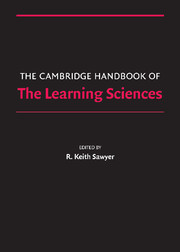Book contents
- Frontmatter
- Contents
- Preface
- Contributors
- 1 Introduction
- PART I FOUNDATIONS
- PART II METHODOLOGIES
- PART III THE NATURE OF KNOWLEDGE
- 14 Case-Based Reasoning
- 15 The Knowledge Integration Perspective on Learning and Instruction
- 16 A History of Conceptual Change Research
- 17 Spatial Representations and Imagery in Learning
- 18 Literacy and the Learning Sciences
- PART IV MAKING KNOWLEDGE VISIBLE
- PART V LEARNING TOGETHER
- PART VI LEARNING ENVIRONMENTS
- Afterword: After How Comes What
- Epilogue: The Fundamental Issue in the Learning Sciences
- Author Index
- Subject Index
- References
18 - Literacy and the Learning Sciences
Published online by Cambridge University Press: 05 June 2012
- Frontmatter
- Contents
- Preface
- Contributors
- 1 Introduction
- PART I FOUNDATIONS
- PART II METHODOLOGIES
- PART III THE NATURE OF KNOWLEDGE
- 14 Case-Based Reasoning
- 15 The Knowledge Integration Perspective on Learning and Instruction
- 16 A History of Conceptual Change Research
- 17 Spatial Representations and Imagery in Learning
- 18 Literacy and the Learning Sciences
- PART IV MAKING KNOWLEDGE VISIBLE
- PART V LEARNING TOGETHER
- PART VI LEARNING ENVIRONMENTS
- Afterword: After How Comes What
- Epilogue: The Fundamental Issue in the Learning Sciences
- Author Index
- Subject Index
- References
Summary
At the time this chapter is being written, two billion Instant Messages are being sent daily, 92 percent of public school classrooms in the United States have access to the Internet, the College Board is introducing a test of technological literacy, novelists are publishing their works on-line, prize-winning journalists are setting up Web logs and assuming new identities, public spaces are “war chalked” indicating to passers-by that they are at a location where they can piggyback on a high-speed network supported by a business or resident, Wikipedia – a free-content encyclopedia – is available in 57 languages, and the University of Michigan has negotiated with Google to digitize its seven million volume collection to be accessed by anyone the world over. In short, one needn't look far to find examples of the continual reshaping of literacy by virtue of technologies. In fact, the evolution of literacy is a series of sociotechnical changes; from papyrus, to paper, to printing press, to electronic spaces, technologies have influenced how we use and make meaning with text.
To set the stage for this chapter, consider for a moment the multiple forms of literacy that are required to interpret and learn from a typical Web site. On first entering, one must immediately interpret navigational cues and chart a path that will support knowledge building with the site. Frequently, the user can select from among several media links; simultaneously listening to and reading information, and activating simulations, which also must be interpreted.
- Type
- Chapter
- Information
- The Cambridge Handbook of the Learning Sciences , pp. 299 - 314Publisher: Cambridge University PressPrint publication year: 2005
References
- 1
- Cited by



